The Quiet Man
8.4 /10 1 Votes
89% Rotten Tomatoes Genre Comedy, Drama, Romance Duration Language English | 7.9/10 IMDb Country United States | |||||||||||||||||||||||||||||||||
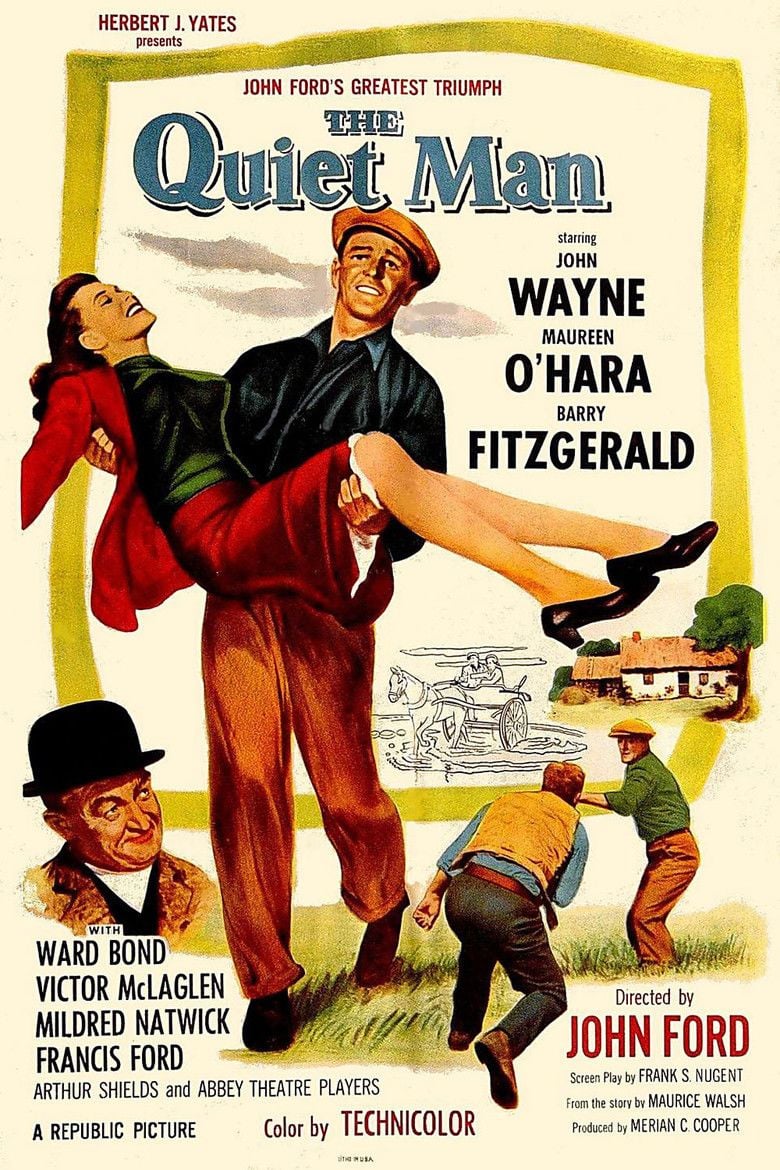 | ||||||||||||||||||||||||||||||||||
Release date July 21, 1952 (1952-07-21) (UK)August 1952 (1952-08) (Venice Film Fest.)August 14, 1952 (1952-08-14) (U.S.) Based on short story byMaurice Walsh Screenplay Maurice Walsh, Frank Nugent, Richard Llewellyn Cast (Sean Thornton), (Mary Kate Danaher), (Squire 'Red' Will Danaher), (Michaleen Oge Flynn), (Father Peter Lonergan), (The Widow Sarah Tillane) Similar movies Rocky Balboa , Rocky , Rocky III , Rocky II , Rocky V , Cinderella Man Tagline Action...Excitement...Romance...Fill the Screen ! | ||||||||||||||||||||||||||||||||||
The quiet man original trailer
The Quiet Man is a 1952 Technicolor American romantic comedy-drama film directed by John Ford. It stars John Wayne, Maureen O'Hara, Barry Fitzgerald, Ward Bond and Victor McLaglen. The screenplay by Frank S. Nugent was based on a 1933 Saturday Evening Post short story of the same name by Maurice Walsh, later published as part of a collection The Green Rushes. The film is notable for Winton Hoch's lush photography of the Irish countryside and a long, climactic, semi-comic fist fight. It was an official selection of the 1952 Venice Film Festival.
Contents
- The quiet man original trailer
- Plot
- Cast notes
- Production
- Music
- Box office
- Critical reception
- In popular culture
- Home media
- References
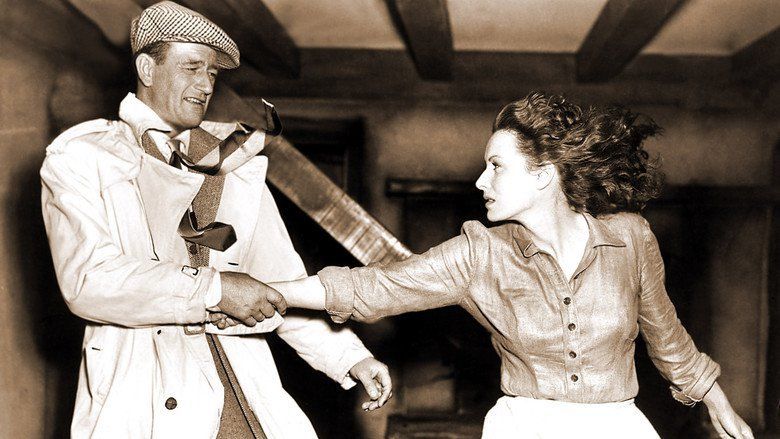
The Quiet Man won the Academy Award for Best Director for John Ford, his fourth, and for Best Cinematography. In 2013, the film was selected for preservation in the United States National Film Registry by the Library of Congress as being "culturally, historically, or aesthetically significant".
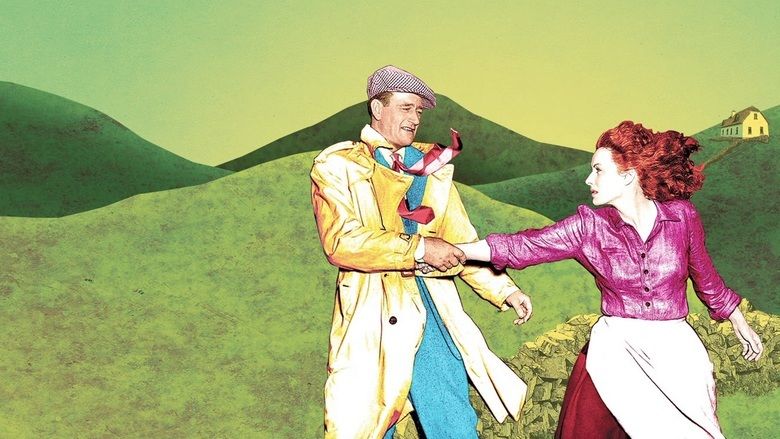
Plot
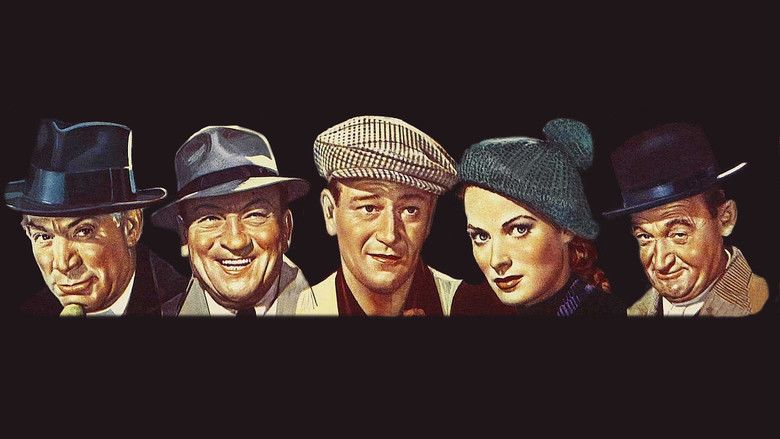
In the 1920s, Sean Thornton (John Wayne), an Irish-born American from Pittsburgh, travels to Ireland to reclaim his family's farm and his birthplace in Inisfree. He meets and falls in love with the fiery Mary Kate Danaher (Maureen O'Hara), the sister of the bullying, loud-mouthed landowner Squire "Red" Will Danaher (Victor McLaglen). Danaher, who had wanted the farm himself, is angry that the Widow Tillane (herself angered by Danaher's admission that he had discussed her in the local pub) accepts Sean's bid, and retaliates by refusing consent for his sister to marry. Several town locals, including the Catholic priest, Father Lonergan (Ward Bond), conspire to trick him into believing that the wealthy Widow Tillane (Mildred Natwick) wants to marry him, but only if Mary Kate is no longer living in his house. After learning the truth on Sean and Mary Kate's wedding day, an enraged Will refuses to give his sister her dowry which is made up of a large sum of money and her family possessions passed down from her mother.
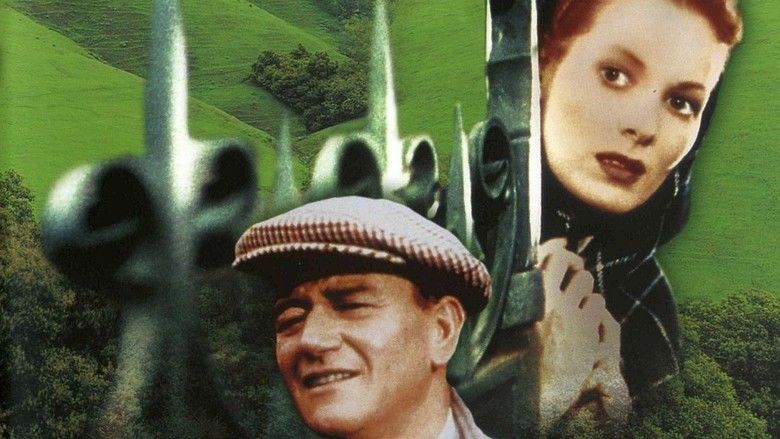
Sean, unschooled in Irish customs, cares nothing about the dowry, but to Mary Kate the dowry represents her independence, identity, and pride. She feels passionately and intensely that the dowry is hers and is needed to validate her marriage to Sean. Angered and shamed by Sean's refusal to confront her brother and demand what is legally hers, she brands him a coward, and, despite living together, they are quickly estranged as husband and wife. In the morning they find that others in the village had visited Will and pressured him to return Mary Kate's furniture, but not her money.
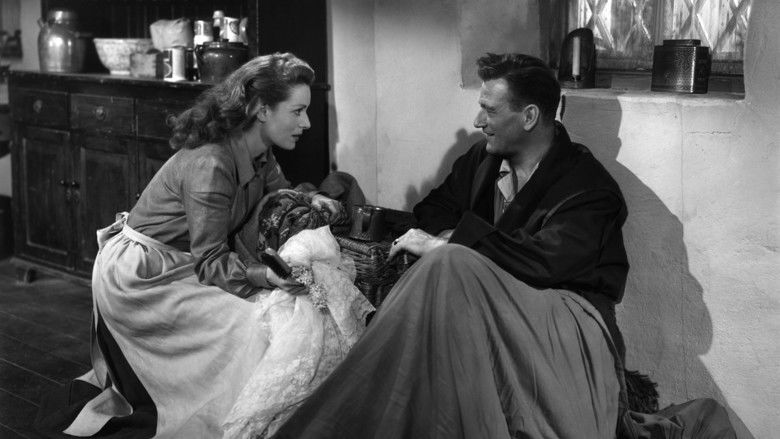
Sean had been a boxer in the United States, a heavyweight challenger known as "Trooper Thorn". After accidentally killing an opponent in the ring, Sean hung up his gloves, vowing never to fight again. This is known to only one person in the village, the Church of Ireland minister, the Rev. Playfair (Arthur Shields), who once upon a time had been the lightweight champion and so understands Thornton's internal conflict over the fight.
In an attempt to force Sean to confront Will, Mary Kate leaves him and boards a train departing Castletown and headed to Dublin. Sean hears that she left for the station and drags her off the train. Followed by the crowding townspeople, he forces her to walk with him the five miles back to Inisfree and directly to the Danaher farm. Sean demands that Will hand over her dowry. When Will refuses, he throws Mary Kate back at Will, saying that "no dowry, no marriage" is their custom not his, shocking the two and shaming Will into finally paying the monetary part of his sister's dowry. Sean promptly throws the money into a nearby furnace which Mary Kate holds open, showing that Mary Kate never cared about the money, but only what it represented.
After a proud Mary Kate announces so all can hear, that she will now return home to prepare his supper, and departs, Will punches Sean, and a long, memorable fistfight ensues between the two, drawing crowds from miles around. They slug it out through the village, stop for a drink, brawl again, then, somewhat drunk, admit grudging mutual respect and the two return to Sean and Mary Kate's home for supper, where it is implied the rift is healed. Sean regains Mary Kate's love and respect. In the aftermath it is shown that Will and the Widow Tillane begin courting, and "peace is returned to Inisfree".
Cast notes
Production
The film was something of a departure for Wayne and Ford, who were both known mostly for Westerns and other action-oriented films. It was also a departure for Republic Pictures, which backed Ford in what was considered a risky venture at the time. It was the only time the studio, known for low budget B-movies, released a film that would receive an Oscar nomination for Best Picture.
Ford read the story in 1933 and soon purchased the rights to it for $10. The story's author was paid another $2,500 when Republic bought the idea, and he received a final payment of $3,750 when the film was actually made. Republic Pictures agreed to finance the film with O'Hara and Wayne starring and Ford directing, but only if all three agreed to first film a Western with Republic. They did, and after completing Rio Grande, they headed for Ireland to start shooting.
One of the conditions that Republic placed on Ford was that the film run under two hours. However, the finished picture was two hours and nine minutes. When screening the film for Republic executives, Ford stopped the film at approximately two hours in, on the verge of the climactic fistfight. Republic executives relented and allowed the film to run its full length. It was one of the few films that Republic filmed in Technicolor; most of the studio's other color films were made in a more economical process known as Trucolor.
The film employed many actors from the Irish theatre, including Barry Fitzgerald's brother, Arthur Shields, as well as extras from the Irish countryside, and it is one of the few Hollywood movies in which the Irish language can be heard.
Filming commenced on June 7, 1951. All of the outdoor scenes were shot on location in Ireland in County Mayo and County Galway. The inside scenes were filmed toward the end of July at the Republic Studios in Hollywood.
The story is set in the fictitious community of Inisfree. This is not the same as the Lake Isle of Innisfree, a place in Lough Gill on the Sligo–Leitrim border made famous by poet William Butler Yeats, which is a tiny island. Many scenes for the film were actually shot in and around the village of Cong, County Mayo, on the grounds of Cong's Ashford Castle. Cong is now a wealthy small town and the castle a 5-star luxury hotel. The connections with the film have led to the area becoming a tourist attraction. In 2008, a pub opened in the building used as the pub in the film (it had actually been a shop at the time when the movie was shot); the pub hosts daily re-runs of the film on DVD. The Quiet Man Fan Club holds its annual general meeting in Ashford Castle. Other locations in the film include Thoor Ballylee, Co. Galway, home of poet W.B. Yeats for a period, Ballyglunin railway station near Tuam Co. Galway, which was filmed as Castletown station, and various places in Connemara Co. Galway and Co. Mayo. Among those are Lettergesh beach, where the horse race scene was filmed, the Quiet Man Bridge, signposted off the N59 road between Maam Cross and Oughterard and the "White O'Morn" cottage. The latter is located on R336 south of Maam, but has long ago fallen into ruin.
The film also presents Ford's depiction of an idealized Irish society, with no social divisions based on class or religion. The Catholic priest, Father Lonergan, and the Protestant Rev. Playfair maintain a strong friendly relationship throughout the film – which represented the norm in what was then the Irish Free State. (Religious tensions occurred in the 1930s, but were the norm only in Northern Ireland.) The only allusions to Anglo-Irish animosity occur after the happy couple is married and a congratulatory toast expresses the wish that they live in "national freedom" (the term national has been censored from most editions) and before the final donnybrook when Thornton demands his wife's dowry from Danaher. Danaher asks Hugh Forbes, who had been commander of the local Irish Republican Army unit during the fight to expel the British, "So the IRA is in this too, ah", to which Forbes replies, "If it were, not a scorched stone of your fine house would be standing."
Music
Ford chose his friend, Hollywood composer Victor Young, to compose the score for the film. Young sprinkled the soundtrack with many Irish airs such as the "Rakes of Mallow" and "The Wild Colonial Boy". One piece of music, chosen by Ford himself, is most prominent: the melody the "Isle of Innisfree", written not by Young, but by the Irish policeman/songwriter Richard Farrelly. The melody of the "Isle of Innisfree", which is first heard over the opening credit sequence with Ashford Castle in the background, becomes the principal musical theme of The Quiet Man. The melody is reprised at least eleven times throughout the film.
The upbeat melody comically hummed by Michaeleen Oge Flynn and later played on the accordion is the "Rakes of Mallow".
A portion of the Irish version of "The Wild Colonial Boy" is played throughout the film.
When Maureen O'Hara died in October 2015, her family stated she listened to music from The Quiet Man during her final hours. Filmmaker George A. Romero was also said to have died listening to the score.
Box office
The film was a financial success, grossing $3.8 million in its first year of release. This was among the top ten grosses of the year. It was the seventh most popular film for British audiences in 1952.
Critical reception
The Quiet Man has a 90% approval rating on Rotten Tomatoes, with the critical consensus stated as, "Director John Ford and star John Wayne depart the Western for the Irish countryside, and the result is a beautifully photographed, often comedic romance."
In popular culture
A kissing scene between Sean and Mary Kate is shown in E.T. the Extra-Terrestrial (1982) when E.T. watches television. E.T. is interested and moved by the scene; his telepathic contact with Elliot causes the boy to re-enact it while he is at school with a girl, portrayed by a young Erika Eleniak.
The film inspired Donnybrook!, a 1961 Broadway musical.
John Williams' score for the film 1941 (1979) borrows the Rakes of Mallow motif from The Quiet Man. It is used to show the building violence between the soldiers and sailors.
The film is referenced in the 2015 romantic drama film Brooklyn.
Irish author Des MacHale has written four books about the film.
Home media
It was first released on DVD December 14, 1998 by Artisan Home Entertainment. It was also released 4 years later on a Collector's edition DVD on October 22, 2002 by Artisan. The Special features on this edition include "The Making of the Quiet Man" Documentary with Leonard Maltin, and "The Joy of Ireland" Documentary with Maureen O'Hara and Andrew V. McLaglen, and "Remembering The Quiet Man Montage".
On January 22, 2013 Olive Films released The Quiet Man on DVD and for the first time on Blu-ray, as a 60th Anniversary Special edition. It included the documentary "The Making of the Quiet Man" with Leonard Maltin.
In 2010 there was a documentary called Dreaming The Quiet Man made about the journey and making of The Quiet Man. It was narrated by Gabriel Byrne, and had interviews with Peter Bogdanovich, Martin Scorsese, Charles F. Fitzsimons, and Maureen O'Hara. It was released on DVD and Blu-ray for the first time on March 24, 2015.
References
The Quiet Man WikipediaThe Quiet Man IMDbThe Quiet Man Rotten TomatoesThe Quiet Man themoviedb.org
